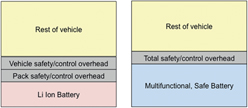Crossref Citations
This article has been cited by the following publications. This list is generated based on data provided by
Crossref.
Young, Kwo-hsiung
Ng, K.
and
Bendersky, Leonid
2016.
A Technical Report of the Robust Affordable Next Generation Energy Storage System-BASF Program.
Batteries,
Vol. 2,
Issue. 1,
p.
2.
Kukreja, J.
Nguyen, T.
Siegmund, T.
Chen, W.
Tsutsui, W.
Balakrishnan, K.
Liao, H.
and
Parab, N.
2016.
Crash analysis of a conceptual electric vehicle with a damage tolerant battery pack.
Extreme Mechanics Letters,
Vol. 9,
Issue. ,
p.
371.
Liang, Yanliang
Jing, Yan
Gheytani, Saman
Lee, Kuan-Yi
Liu, Ping
Facchetti, Antonio
and
Yao, Yan
2017.
Universal quinone electrodes for long cycle life aqueous rechargeable batteries.
Nature Materials,
Vol. 16,
Issue. 8,
p.
841.
Chen, Qianli
and
Braun, Artur
2017.
Protons and the hydrogen economy.
MRS Energy & Sustainability,
Vol. 4,
Issue. 1,
Meyendorf, Norbert G.
Ladpli, Purim
Kopsaftopoulos, Fotis
Nardari, Raphael
and
Chang, Fu-Kuo
2017.
Battery charge and health state monitoring via ultrasonic guided-wave-based methods using built-in piezoelectric transducers
.
Vol. 10171,
Issue. ,
p.
1017108.
Adam, Till
Liao, Guangyue
Petersen, Jan
Geier, Sebastian
Finke, Benedikt
Wierach, Peter
Kwade, Arno
and
Wiedemann, Martin
2018.
Multifunctional Composites for Future Energy Storage in Aerospace Structures.
Energies,
Vol. 11,
Issue. 2,
p.
335.
Cano, Zachary P.
Banham, Dustin
Ye, Siyu
Hintennach, Andreas
Lu, Jun
Fowler, Michael
and
Chen, Zhongwei
2018.
Batteries and fuel cells for emerging electric vehicle markets.
Nature Energy,
Vol. 3,
Issue. 4,
p.
279.
Rahmanullah, Edwin Sholeh
Nurjanah, Siti
Baaken, T.
van der Sijde, P.
Maas, G.
Zaidir
and
Yahya, M.
2018.
Influence of Product Quality, Price and Supporting Infrasturcture to Perceived Value and Interest in Buying of Electric Motorcycle.
MATEC Web of Conferences,
Vol. 215,
Issue. ,
p.
02006.
Zhang, Yamin
Wu, Yutong
Ding, Haoran
Yan, Yu
Zhou, Zhubo
Ding, Yong
and
Liu, Nian
2018.
Sealing ZnO nanorods for deeply rechargeable high-energy aqueous battery anodes.
Nano Energy,
Vol. 53,
Issue. ,
p.
666.
Ding, Yuanli
Cano, Zachary P.
Yu, Aiping
Lu, Jun
and
Chen, Zhongwei
2019.
Automotive Li-Ion Batteries: Current Status and Future Perspectives.
Electrochemical Energy Reviews,
Vol. 2,
Issue. 1,
p.
1.
Wu, T.-H.
Zhang, Y.
Althouse, Z.D.
and
Liu, N.
2019.
Nanoscale design of zinc anodes for high-energy aqueous rechargeable batteries.
Materials Today Nano,
Vol. 6,
Issue. ,
p.
100032.
Ryu, Hoon‐Hee
Park, Nam‐Yung
Yoon, Dae Ro
Kim, Un‐Hyuck
Yoon, Chong S.
and
Sun, Yang‐Kook
2020.
New Class of Ni‐Rich Cathode Materials Li[NixCoyB1−x−y]O2 for Next Lithium Batteries.
Advanced Energy Materials,
Vol. 10,
Issue. 25,
Li, Leilei
Wen, Yuehua
Ming, Hai
Zhang, Hao
Bian, Wenyi
Lin, Haiping
and
Yang, Yusheng
2020.
Insight into the Li- and Zn-Ion Synergistic Effect for Benzoquinone-Based Anodes in Aqueous Batteries.
ACS Applied Energy Materials,
Vol. 3,
Issue. 9,
p.
8309.
Kong, Long
Wang, Liping
Zhu, Jinlong
Bian, Juncao
Xia, Wei
Zhao, Ruo
Lin, Haibin
and
Zhao, Yusheng
2021.
Configuring solid-state batteries to power electric vehicles: a deliberation on technology, chemistry and energy.
Chemical Communications,
Vol. 57,
Issue. 94,
p.
12587.
Kumar, Pravin
Singh, Rajesh Kr
Paul, Justin
and
Sinha, Oikantik
2021.
Analyzing challenges for sustainable supply chain of electric vehicle batteries using a hybrid approach of Delphi and Best-Worst Method.
Resources, Conservation and Recycling,
Vol. 175,
Issue. ,
p.
105879.
Zhu, Penghui
Han, Jiahao
and
Pfleging, Wilhelm
2021.
Characterization and Laser Structuring of Aqueous Processed Li(Ni0.6Mn0.2Co0.2)O2 Thick-Film Cathodes for Lithium-Ion Batteries.
Nanomaterials,
Vol. 11,
Issue. 7,
p.
1840.
Natarajan, Subramanian
Akshay, Manohar
and
Aravindan, Vanchiappan
2022.
Recycling/Reuse of Current Collectors from Spent Lithium‐Ion Batteries: Benefits and Issues.
Advanced Sustainable Systems,
Vol. 6,
Issue. 3,
Wang, Yinan
and
Chang, Fu-Kuo
2022.
Numerical and experimental evaluation of mechanical performance of the multifunctional energy storage composites.
Journal of Composite Materials,
Vol. 56,
Issue. 2,
p.
199.
Strehle, Benjamin
Zünd, Tanja
Sicolo, Sabrina
Kiessling, Aleksandr
Baran, Volodymyr
and
Gasteiger, Hubert A.
2022.
Correlating the Voltage Hysteresis in Li- and Mn-Rich Layered Oxides to Reversible Structural Changes by Using X-ray and Neutron Powder Diffraction.
Journal of The Electrochemical Society,
Vol. 169,
Issue. 2,
p.
020554.
Yang, Chen
2022.
Running battery electric vehicles with extended range: Coupling cost and energy analysis.
Applied Energy,
Vol. 306,
Issue. ,
p.
118116.
